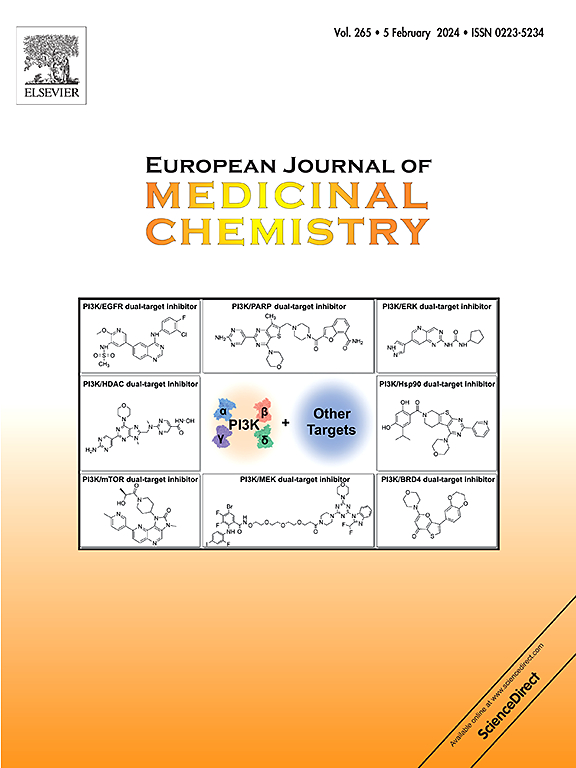Discovery of thiazolylcyanovinyl benzopyridone acids: Potential new generation antibacterial oxacins?
IF 6
2区 医学
Q1 CHEMISTRY, MEDICINAL
引用次数: 0
Abstract
Here we reported a unique class of new structural thiazolylcyanovinyl benzopyridone acids (TBAs) with large potential to defeat the intractable global bacterial resistance. Some prepared TBAs demonstrated broad-spectrum antibacterial ability, especially ethyl TBA 7b gave low MIC values of 0.25–0.5 μg/mL against all the tested bacteria, superior to norfloxacin and clinafloxacin. The highly active molecule 7b not only showed imperceptible hemolysis, cytotoxicity, toxicity in vivo and drug resistance, but also effectually eradicated mature biofilm and rapidly sterilized Klebsiella pneumonia. Moreover, TBA 7b exhibited high therapeutic efficacy in mouse model of wound infection. Mechanism explorations implied that TBA 7b could intercalate into DNA and act on gyrase-DNA complex to block DNA supercoiling, trigger oxidative stress and inhibit lactate dehydrogenase to reduce metabolism, resulting in bacterial death and intracellular protein leakage. These results suggested that thiazolylcyanovinyl benzopyridone acids should hold the large promise for being exploited as next-generation antibacterial oxcains.


噻唑基氰堇酰基苯并吡啶酮酸的发现:潜在的新一代抗菌草酸?
在这里,我们报道了一类独特的新结构噻唑基氰乙烯基苯并吡啶酮酸(TBAs),具有很大的潜力来击败棘手的全球细菌耐药性。部分制备的TBA具有广谱抗菌能力,其中乙基tba7b对所有细菌的MIC值较低,为0.25 ~ 0.5 μg/mL,优于诺氟沙星和克林沙星。高活性分子7b不仅具有不易察觉的溶血作用、细胞毒性、体内毒性和耐药作用,而且能有效地根除成熟生物膜,迅速杀灭肺炎克雷伯菌。此外,tba7b在小鼠伤口感染模型中表现出较高的治疗效果。机制探索表明,TBA 7b可嵌入DNA,作用于gyase -DNA复合体,阻断DNA超缠绕,引发氧化应激,抑制乳酸脱氢酶,降低代谢,导致细菌死亡和细胞内蛋白渗漏。这些结果表明,噻唑基氰堇酰基苯并吡啶酮酸有望被开发为下一代抗菌牛嘌呤。
本文章由计算机程序翻译,如有差异,请以英文原文为准。
求助全文
约1分钟内获得全文
求助全文
来源期刊
CiteScore
11.70
自引率
9.00%
发文量
863
审稿时长
29 days
期刊介绍:
The European Journal of Medicinal Chemistry is a global journal that publishes studies on all aspects of medicinal chemistry. It provides a medium for publication of original papers and also welcomes critical review papers.
A typical paper would report on the organic synthesis, characterization and pharmacological evaluation of compounds. Other topics of interest are drug design, QSAR, molecular modeling, drug-receptor interactions, molecular aspects of drug metabolism, prodrug synthesis and drug targeting. The journal expects manuscripts to present the rational for a study, provide insight into the design of compounds or understanding of mechanism, or clarify the targets.

 求助内容:
求助内容: 应助结果提醒方式:
应助结果提醒方式:


